Introduction
Navigating the complexities of Down syndrome requires a comprehensive understanding of its diverse spectrum, recognizing that each individual possesses unique abilities and faces distinct challenges. Beyond the well-known chromosomal anomaly, factors such as genetics, environment, and early intervention significantly shape the developmental paths of those with Down syndrome. This article delves into the broad spectrum of abilities, highlighting the importance of tailored support and interventions that enable individuals to thrive.
It explores recent research findings, societal influences, and the crucial role of early intervention in enhancing cognitive growth, life satisfaction, and overall well-being. By understanding and embracing this diversity, parents and advocates can better support their children's journey, ensuring they reach their full potential and lead fulfilling lives.
Understanding the Spectrum of Down Syndrome
'Down condition encompasses a broad spectrum of abilities and challenges, extending far beyond the chromosomal anomaly commonly associated with it.'. This spectrum highlights the individuality of each person with Down's condition, as no two individuals share the same experience. Factors such as genetics, environment, and early intervention play crucial roles in shaping the developmental paths of individuals with Down's condition.
For instance, research underscores the importance of physical and cognitive exercises in enhancing cognitive growth. The Mindsets study, published in the International Journal of Environmental Research and Public Health, revealed that short bursts of walking could significantly enhance information processing and attention in adults with Down's condition within just eight weeks. This investigation, involving 83 participants from 10 countries, marks a breakthrough in understanding the benefits of exercise for cognitive development.
Furthermore, the Down Condition Societal Services and Supports Survey (DS-4S) demonstrates the variability in opportunities available to people with Down condition, influenced by their social, economic, and political environments. Despite uniform genetic factors, the quality of life for individuals with Down's condition varies significantly across different countries, underscoring the need for tailored support systems.
The development of social perspectives and legal actions, like the Individuals with Disabilities Education Act, has also aided in better results for people with Down's condition. Since the 1980s, life expectancy has more than doubled, reflecting better healthcare and inclusive education. Today, many people with Down condition learn to read, write, and live independently, highlighting the diverse capabilities within this spectrum.
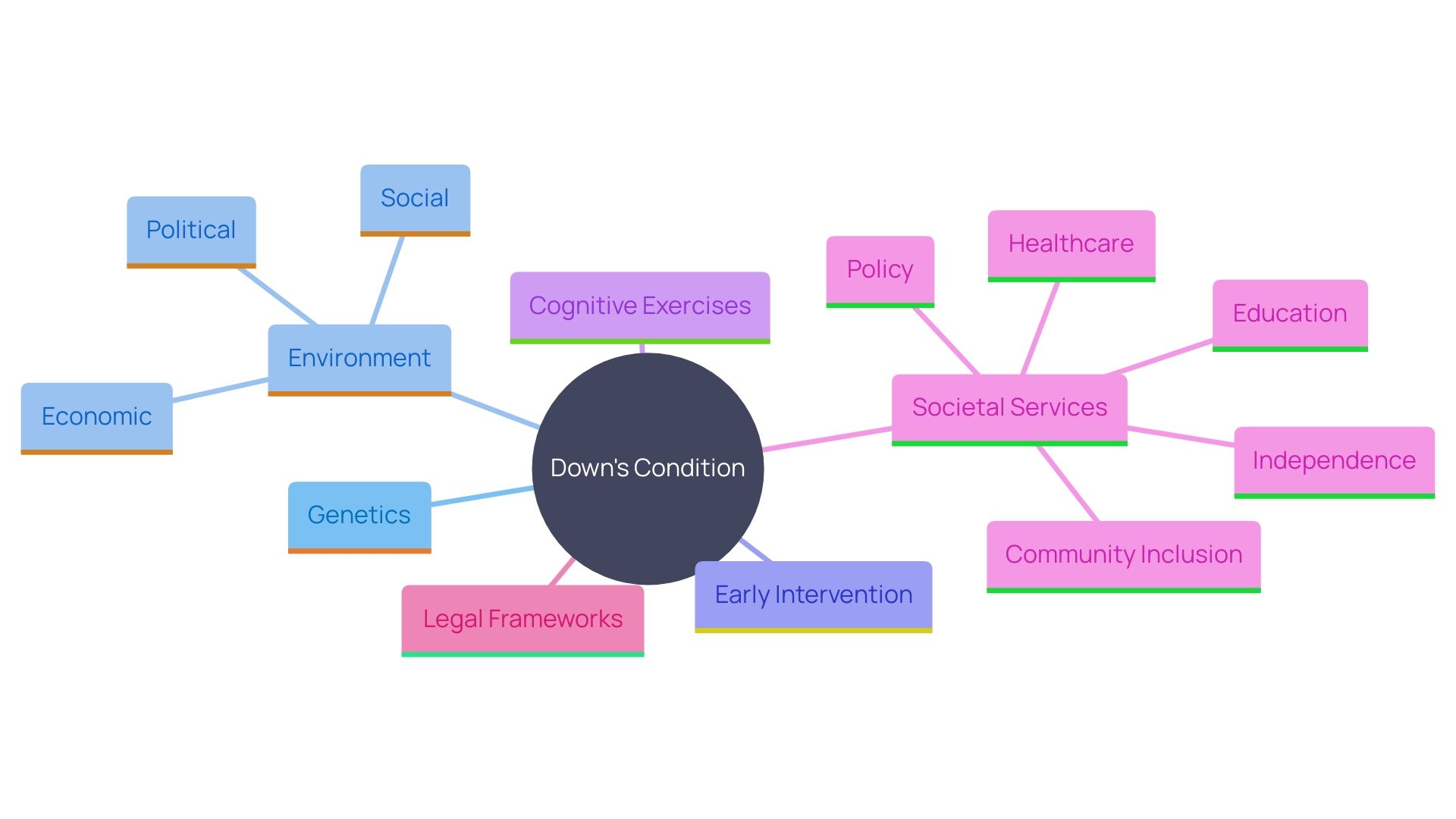
Range of Abilities in Down Syndrome
Individuals with Down syndrome exhibit a diverse array of abilities, spanning cognitive, social, and physical domains. While some may face significant challenges, others demonstrate remarkable strengths in areas such as music, art, and social interaction. This variability underscores the importance of recognizing each individual as unique, with their own set of skills and potential. Recent studies, such as the Mindsets study published in the International Journal of Environmental Research and Public Health, highlight how tailored support can enhance life satisfaction and mood. This study, involving 83 participants from 10 countries, found that physical activity and cognitive training significantly improved life satisfaction and mood for adults with Down syndrome. By incorporating programs like light physical exercise and cognitive activities provided by BrainHQ, people can experience improvements in self-efficacy and overall quality of life. Comprehending this range can assist parents and advocates in customizing support and interventions that enable people to flourish. As stated by researchers, the role of exercise in cognitive development signifies a breakthrough in considering what is optimal for adults with Down condition, expanding the limits of conventional methods and creating new pathways for improving their well-being.
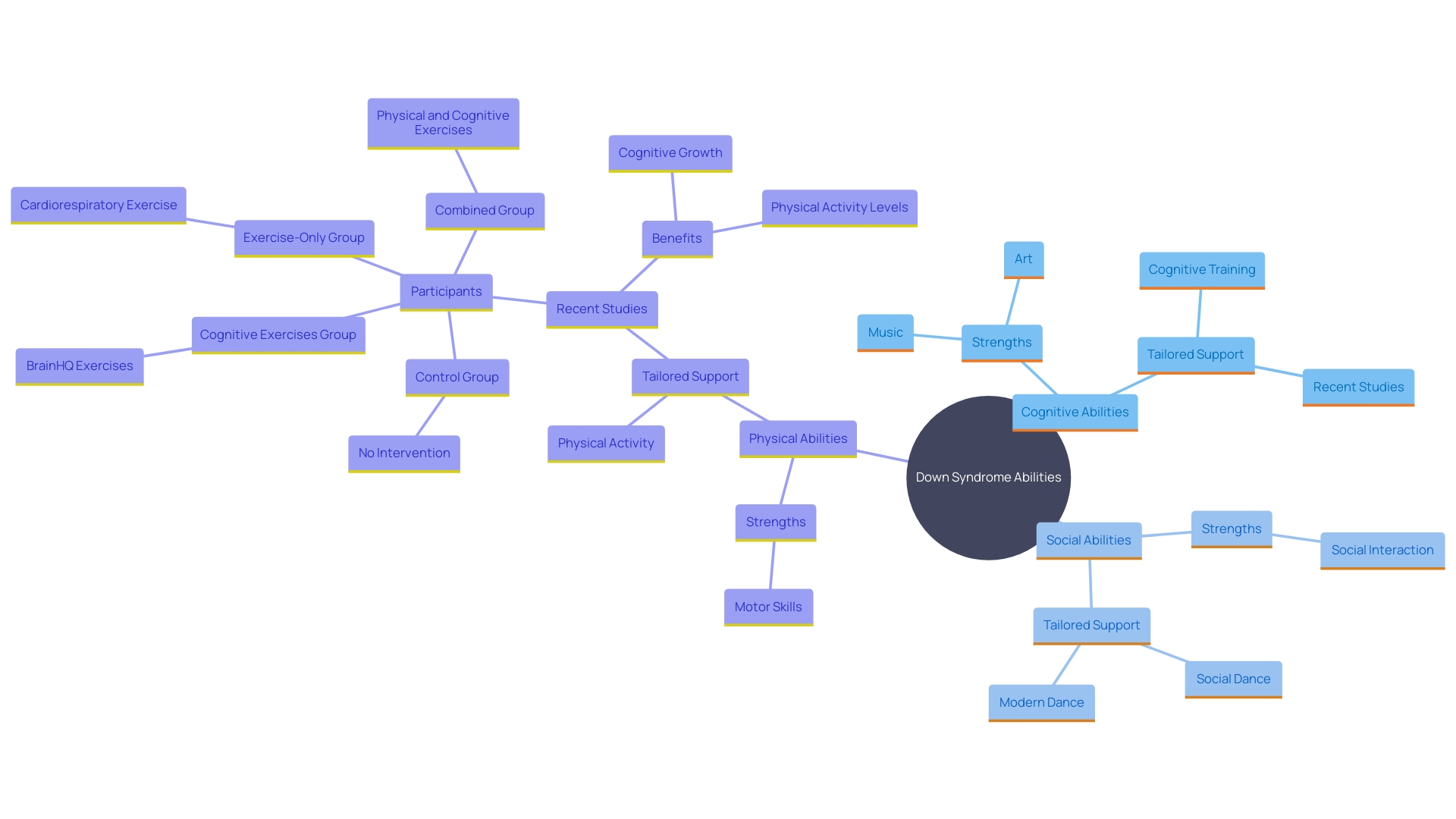
Physical Symptoms and Characteristics
Down condition is linked to a unique collection of physical traits, but these can differ significantly among persons. Common traits include unique facial features, short stature, and hypotonia (decreased muscle tone). Importantly, these physical attributes do not determine a person's capabilities or potential. Research highlights that exercise plays a crucial role in cognitive growth and overall well-being for individuals with Down condition. Studies, such as the Mindsets study led by Dr. Dan Gordon and Viviane Merzbach, have shown that regular physical activity, including simple activities like walking, can significantly improve cognitive functions and attention spans. This emphasizes the significance of concentrating on the strengths and abilities of children with Down's condition, rather than merely their physical characteristics. A holistic approach to their development, which includes physical and cognitive exercises, can greatly enhance their quality of life and help them reach their full potential. Embracing this viewpoint enables a more thorough comprehension and assistance of their distinct requirements and capabilities.
Intellectual and Developmental Symptoms
Cognitive abilities in people with Down syndrome can vary widely, ranging from mild to moderate intellectual disabilities. Yet, intellectual development is not a fixed outcome; many individuals make remarkable progress with the right support and interventions. For instance, recent studies have shown that combining physical exercise with cognitive training can lead to significant improvements in cognitive function. The Mindsets study, which involved participants engaging in both physical activities and cognitive exercises, demonstrated substantial enhancements in attention and decision-making skills.
Comprehending the variability in developmental milestones is essential for parents advocating for their offspring's educational and developmental needs. While some children may reach these milestones later than their peers, the potential for growth and learning remains vast. The extended average lifespan and notable progress in the quality of life for people with Down condition emphasize the necessity of customized approaches. Today, many individuals with Down's condition are learning to read and write, participating in regular schooling, and even living independently. These achievements highlight the progress that can be made when appropriate resources and support systems are in place.
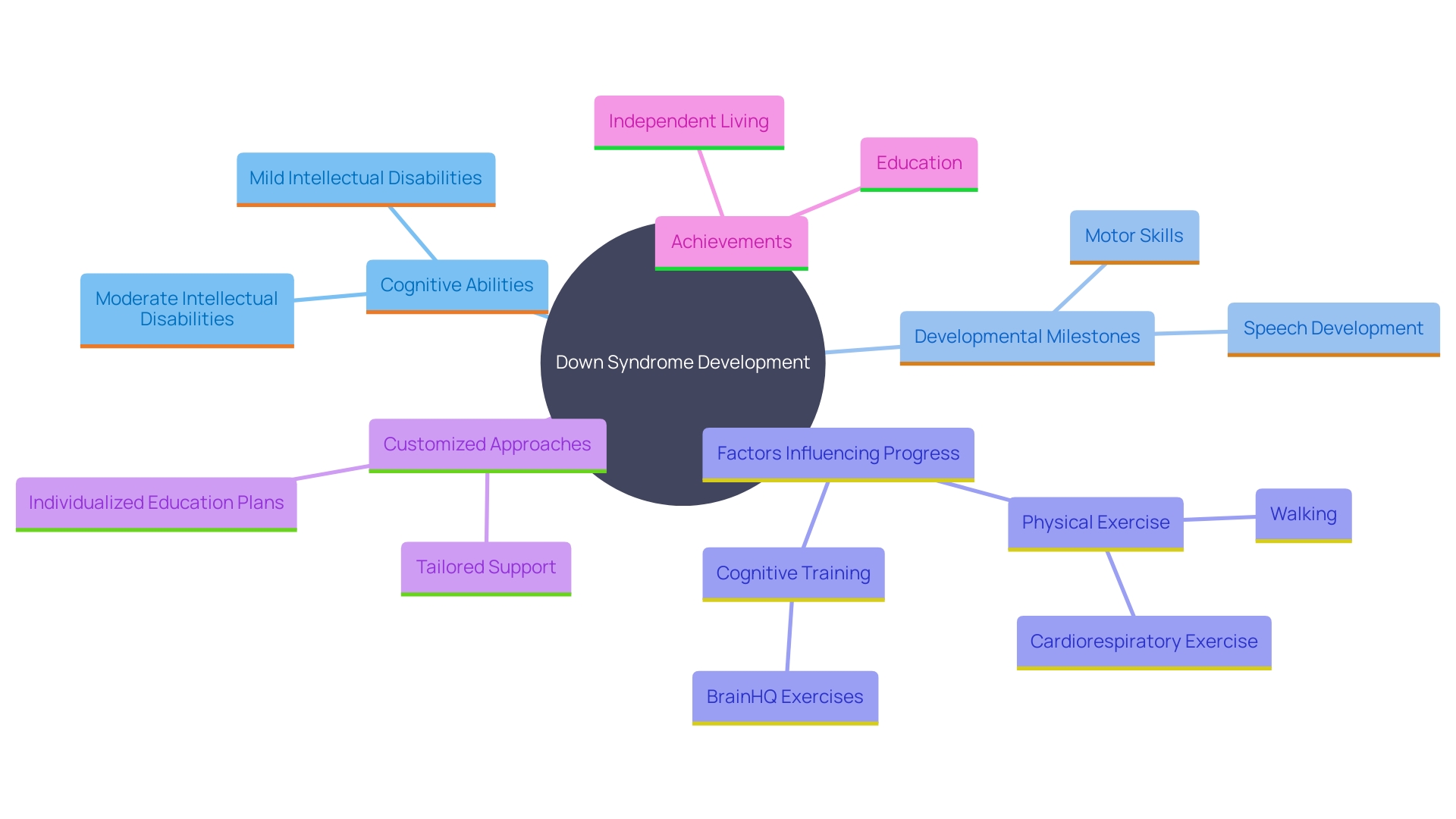
Down Syndrome and Autism Spectrum Disorder (DS-ASD)
Research highlights that there is a significant overlap between Down condition and Autism Spectrum Disorder (ASD). Research indicates that as many as 31-55% of people with ASD may also have intellectual disabilities, and some persons with Down syndrome may be diagnosed with ASD, presenting unique challenges and strengths. Acknowledging this intersection is essential for parents to guarantee thorough assistance for their children, addressing both conditions' needs.
The complexity of managing ASD, which includes core challenges in social communication and restrictive behaviors, requires a comprehensive approach. Interventions must be adaptive to specific needs and foster an environment that supports consistent and informed caregiver practices. This comprehensive method is essential for long-term success in managing behaviors and enhancing the well-being of those with dual diagnoses.
Moreover, recent research highlights the significance of a unified care strategy to tackle mental health challenges common among people with neurodevelopmental conditions. For instance, a study revealed that a decades-old drug, propranolol, significantly reduced anxiety in young people with autism, showcasing the potential for precise and effective treatments.
Incorporating developmental ecology models into care plans is also beneficial. These models emphasize the influence of lived environments and social contexts on the health and development of autistic individuals. Families frequently encounter considerable pressure and need assistance networks to handle the challenges of caring for youngsters with ASD and Down conditions. Social support, peer support, and hope are vital strategies that help alleviate stress, promote family well-being, and provide an optimistic perspective for coping with these conditions.
Thorough, multidisciplinary support, encompassing physical, occupational, speech, and behavioral therapies, is essential to health care strategies for youth with Down's condition and ASD. Early interventions, particularly in speech and communication, are crucial for improving autonomy and social skills. A medical home with primary and specialty care ensures continuity and family-centered care, advocating for the overall development and well-being of the young individual.
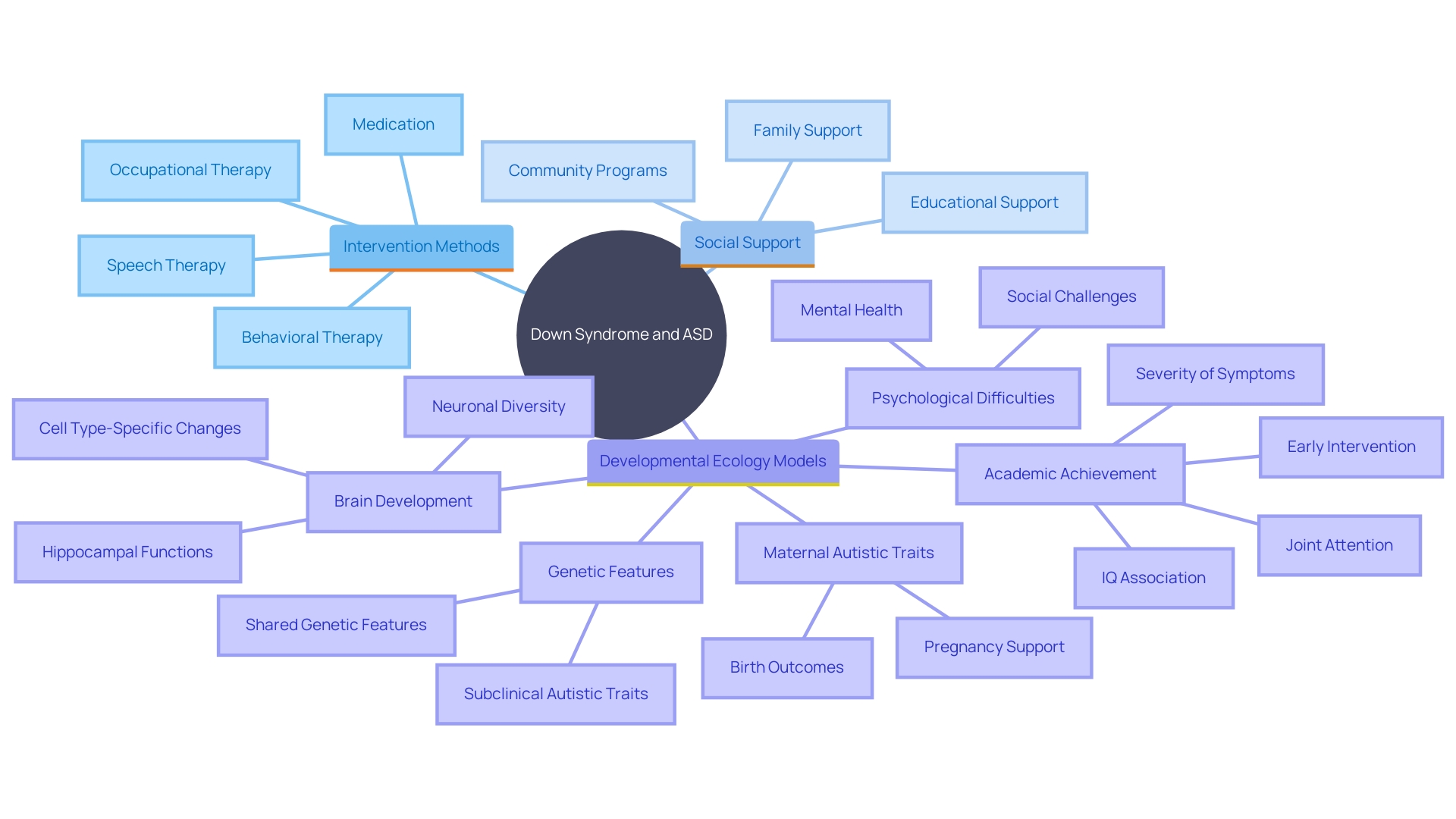
Common Traits and Behaviors in DS-ASD
Children with both Down condition and ASD may exhibit a combination of traits from both conditions, such as difficulties with social communication, repetitive behaviors, and sensory sensitivities. These traits can significantly impact their development and daily interactions. Early intervention is crucial, as therapies tailored to their unique needs can foster meaningful social skills and connections. For instance, physical, occupational, and speech therapies play integral roles in enhancing communication, motor skills, and social behaviors. Research indicates that young individuals with Down condition frequently encounter developmental setbacks in motor abilities and communication, which can be further exacerbated by sensory challenges. By understanding these complexities, parents can better navigate social situations and implement effective strategies to support their children's social development, ultimately improving their quality of life and fostering meaningful interactions.
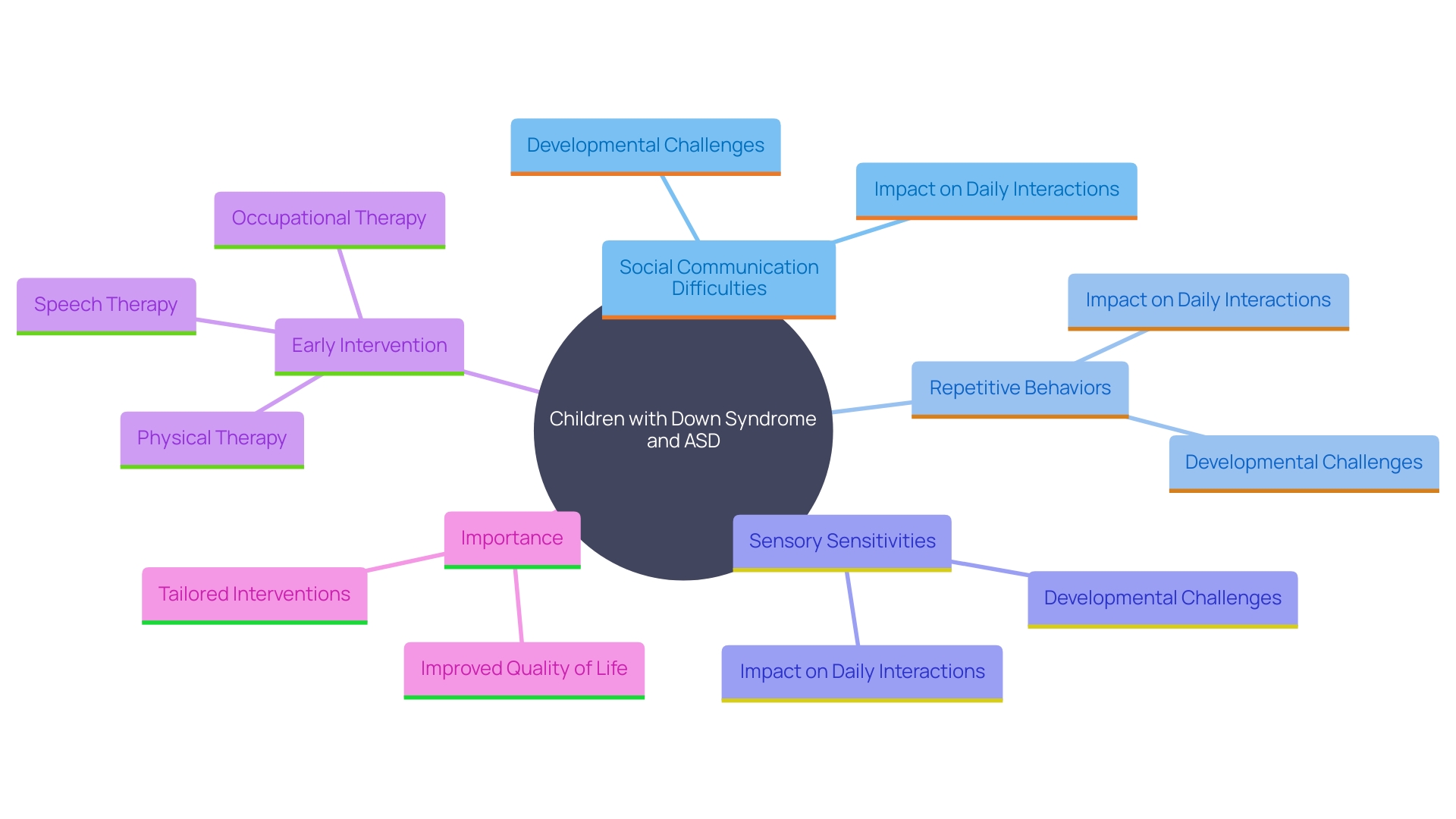
Differences in Presentation: DS-ASD vs. Down Syndrome Alone vs. Autism Alone
Distinguishing between the presentations of Down's condition, DS-ASD, and autism alone is crucial because of the unique traits and difficulties each disorder presents. Down condition typically involves specific genetic traits that can affect various aspects of development, including cognitive and physical abilities, as well as communication skills. Autism Spectrum Disorder (ASD) is characterized by difficulties in social interaction, communication impairments, and repetitive behaviors, which require tailored care and interventions. 'DS-ASD, where Down condition and autism coexist, presents a distinct array of challenges that can affect a young person's growth and everyday functioning.'.
Understanding these differences is pivotal for parents seeking to advocate for appropriate services and support. For instance, individuals with Down syndrome often benefit from early speech, physical, and occupational therapies to enhance their communication and motor skills. In contrast, individuals with ASD may require interventions focusing on social skills and behavior management. Integrating these methods is essential for individuals with DS-ASD to meet their diverse needs effectively.
Parents face significant challenges, including securing appropriate school placements and accessing specialized services, which are often hindered by high demand and resource constraints. Furthermore, the emotional and financial strain on families can be considerable, highlighting the significance of social assistance and peer networks in reducing stress and enhancing well-being. Research emphasizes the advantages of thorough care plans and a multidisciplinary method to address the varied needs of young individuals with these conditions, ensuring that they receive the highest quality of care and opportunities for growth.
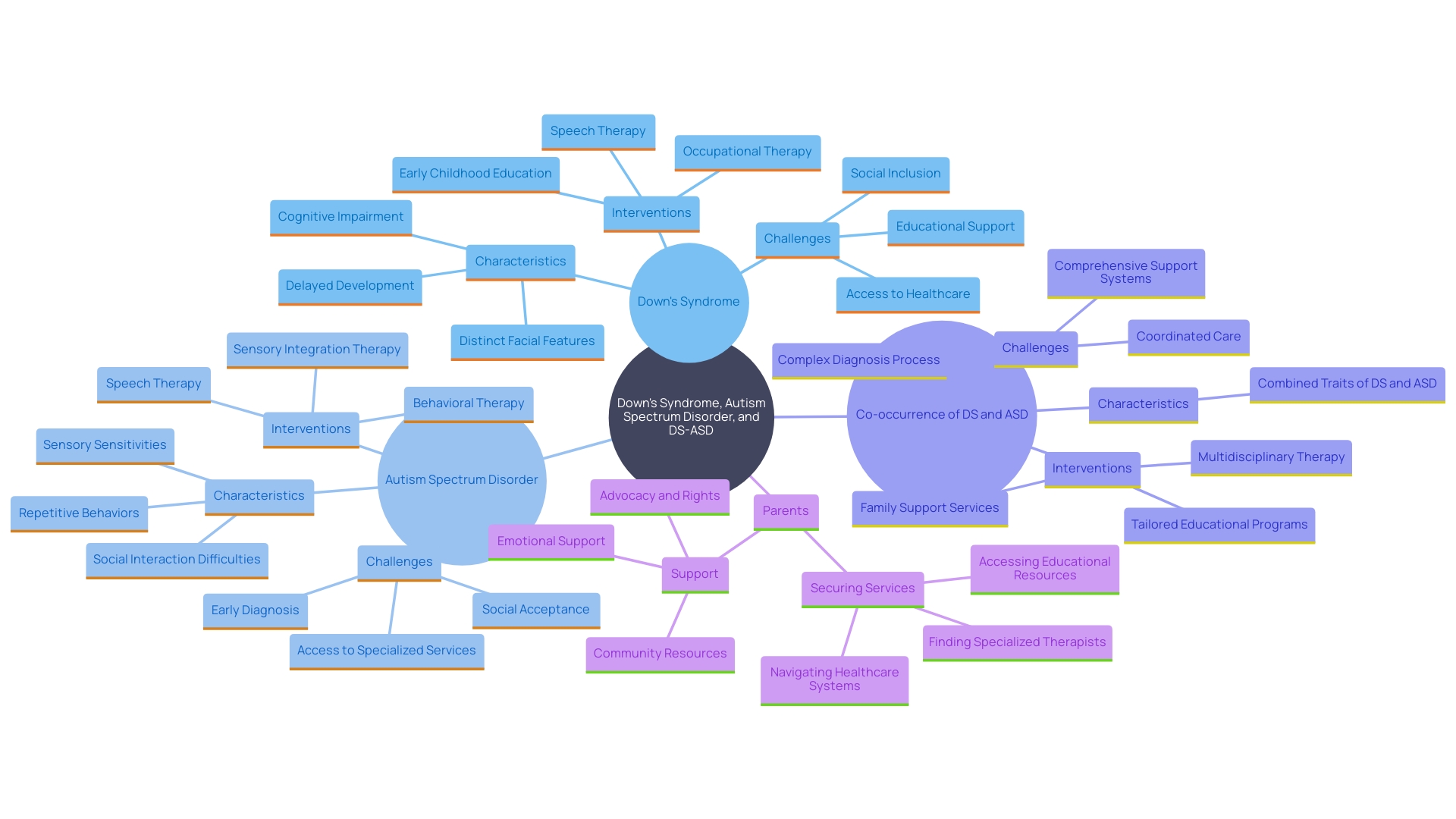
The Importance of Early Intervention and Support
Timely assistance is crucial for maximizing the capabilities of youth with Down syndrome and those on the autism spectrum. Access to appropriate therapies and assistance services can significantly influence developmental outcomes. Studies have shown that developmental interventions can improve social communication in interactions with caregivers, and naturalistic developmental behavioral interventions have been particularly effective in addressing core challenges associated with autism, such as difficulties with social communication. For instance, a study involving low-intensity assistance programs demonstrated that youngsters in these programs were more engaged and used a greater variety of language with their parents compared to those in control groups. Parents in these programs also became more adept at using strategies to support their offspring.
Real-world cases further illustrate the impact of early intervention. In one project, more than 100 young individuals were assessed, leading to early diagnosis and intervention for those at high risk of cerebral palsy. This proactive approach ensured that young individuals received the necessary therapies to improve their developmental outcomes.
Furthermore, early intervention initiatives are becoming more available, enabling families and caregivers to assist in their offspring's development effectively. For instance, practitioners equipped with specialized knowledge can provide tailored interventions that directly address the core social difficulties of autism, enhancing the overall developmental trajectory of young individuals.
Parents are encouraged to seek out resources and support networks to ensure their offspring receive the early help they need to thrive. The importance of empowerment and advocacy throughout this journey cannot be overstated, as early and appropriate intervention can make a significant difference in the lives of children with developmental challenges.
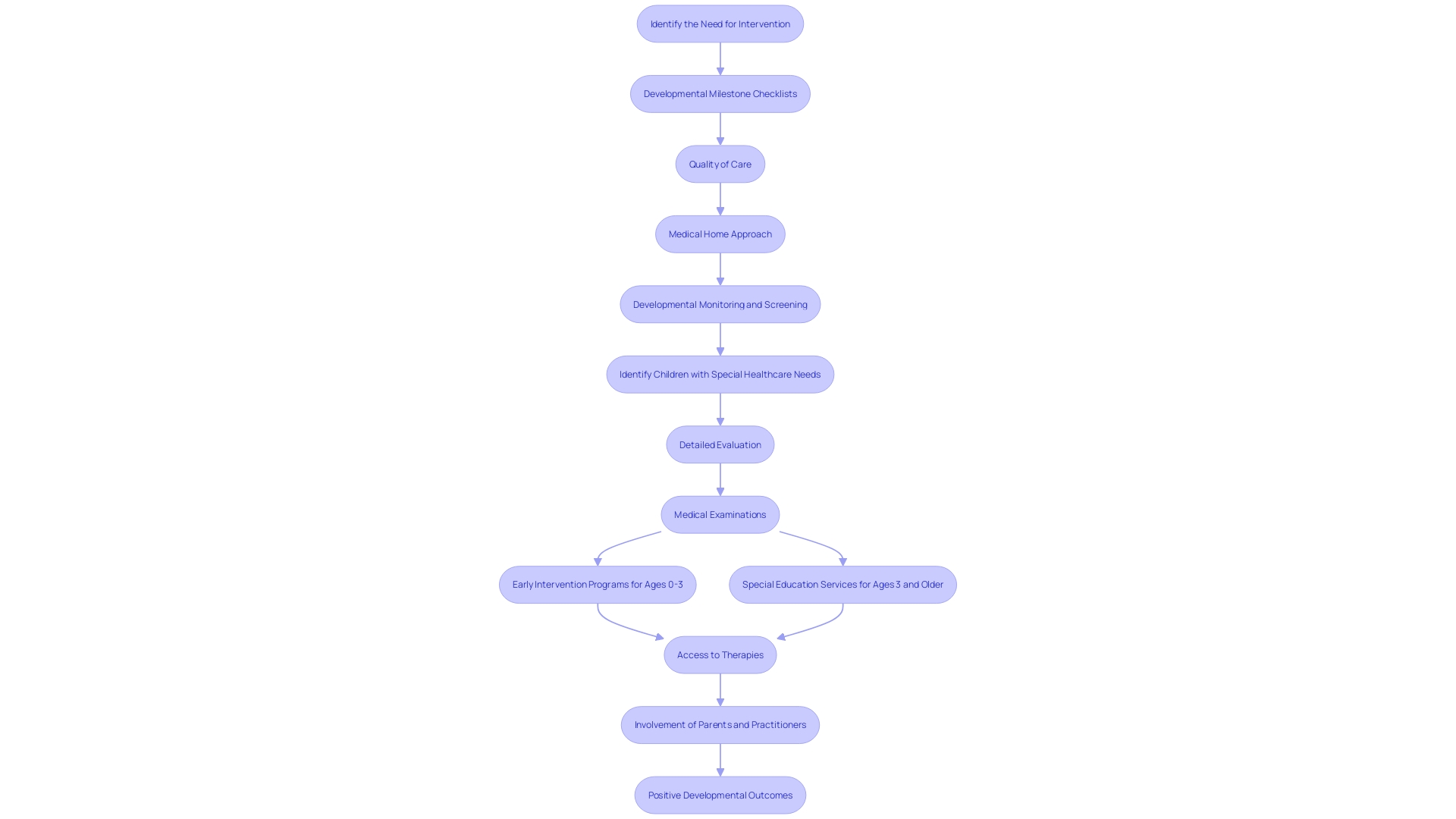
Conclusion
Understanding Down syndrome involves recognizing the unique spectrum of abilities and challenges faced by each individual. Research emphasizes the critical roles of genetics, environment, and early intervention in shaping developmental outcomes. Tailored support systems are essential for enhancing cognitive growth and overall well-being.
The diverse abilities within the Down syndrome community highlight the potential for significant achievements. Studies, such as the Mindsets study, show that integrating physical activity with cognitive training can lead to improved life satisfaction and cognitive function, underscoring the importance of personalized approaches.
Additionally, the overlap between Down syndrome and Autism Spectrum Disorder introduces complexities that require comprehensive care strategies. Recognizing these challenges is vital for parents and advocates in developing effective support plans. Early intervention remains a cornerstone of success, helping families navigate developmental hurdles and fostering meaningful social interactions.
In conclusion, the journey of individuals with Down syndrome is characterized by resilience and potential. By embracing this diversity and advocating for tailored support, parents can empower their children to lead fulfilling lives. Continued advocacy for accessible resources and early interventions is crucial to ensure that every individual has the opportunity to thrive and reach their full potential.




